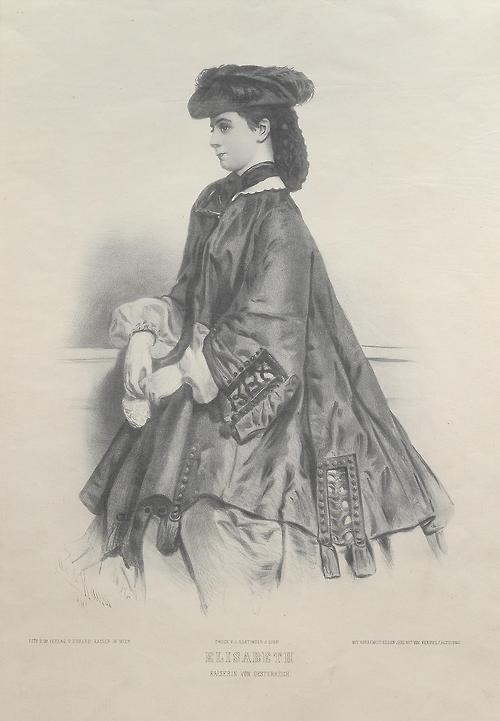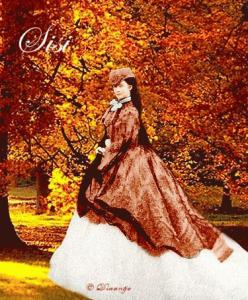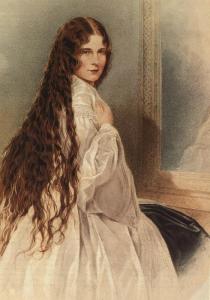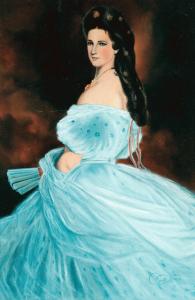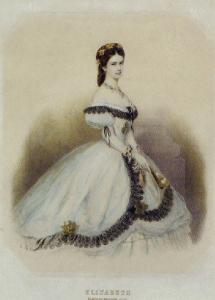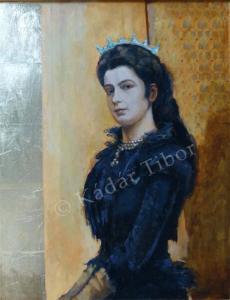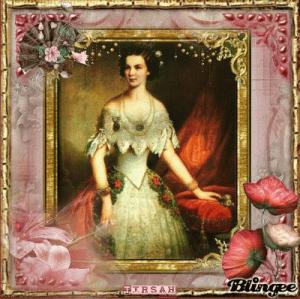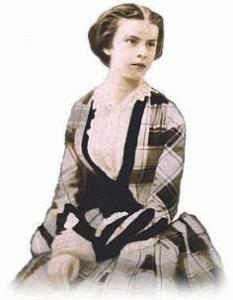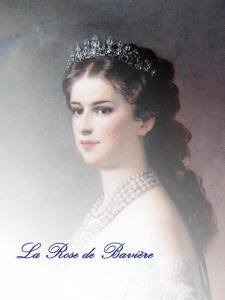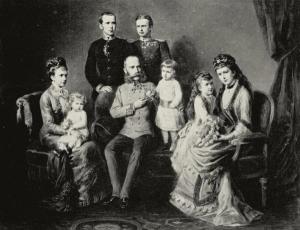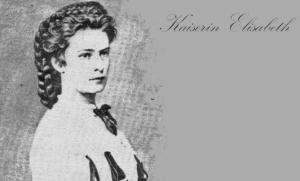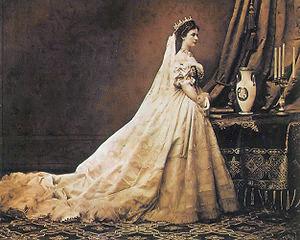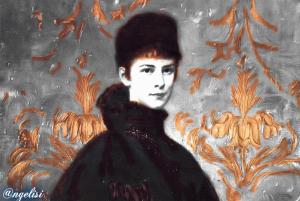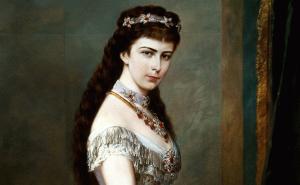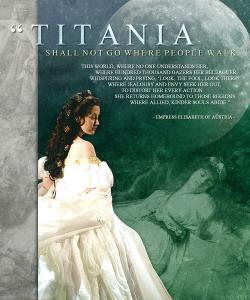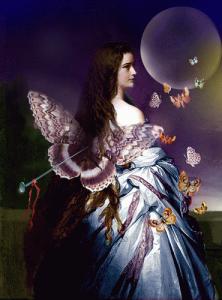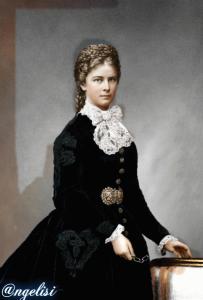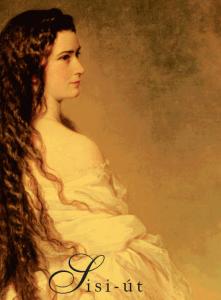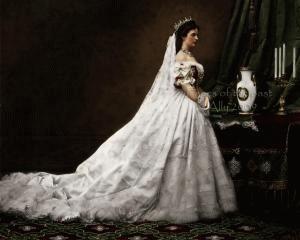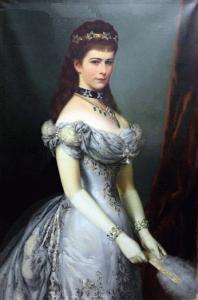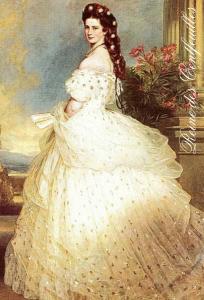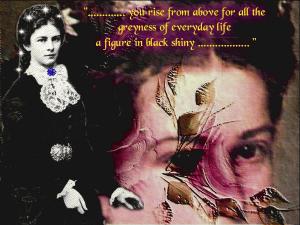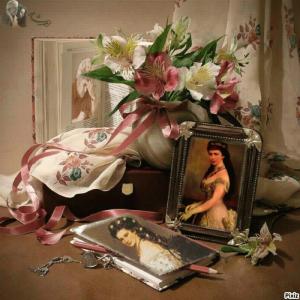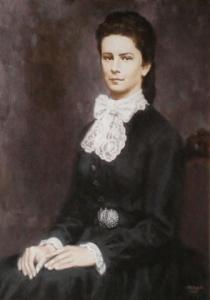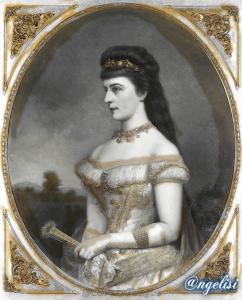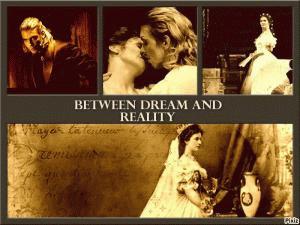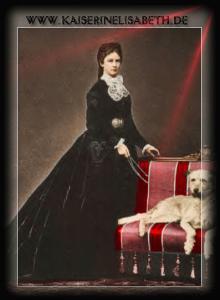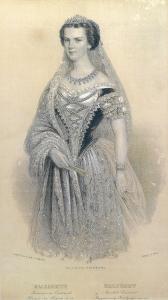Sisi, Adelgunde, Francis V and Franz Josef
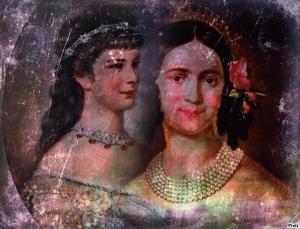
Adelgonda , Francis V , Sisi and Franz Josef
As usual many documents that bought the meetings between the august cousins (Franz Joseph, Elisabeth (Sisi) and Adelgonda) and then also with her husband of Adelgonda: Francesco V are very few. So in addition to the few papers we'll go for deduction. Meanwhile, helping with the beautiful biography of Elena Bianchini Braglia on Adelgonda: there is a beautiful and touching episode where they met the two cousins, and I quote: "In April 1854 Francis V and Adelgonda went to Vienna to attend the wedding of Emperor Franz Joseph with the Duchess Elizabeth ....................... ............ Elizabeth at all accustomed to lavish ceremonies and character rather shy, appeared somewhat disoriented and when at the end of the hearings, their Majesties moved into the ballroom ............... At the sight of many strangers the shy young Empress burst into tears and embarrassed she retired to a 'other room. The ceremony included that no one could talk to her Empress ............ meanwhile the Duchess Adelgonda wandered with her sister Idelgarda in the great hall, attendend to exchange a few words with her cousin. When the young Empress saw the crowd of strangers the cousins childhood friends, she immediately walked towards them .............. she would not that these, as the label prescribed, that kissed her hands hand, but that the embrace. From the expressions astonished the guests realized that he had made an a mistake and for justifey exclaimed " But we are cousins" .................... " So in the book continues with a description of the festivities in which as well she participated and the 13 May Adelgonda and the Dukes of Modena departed from Vienna to Monaco. From this touching episode, you can already deduce that Sisi and Adelgonda (and her sisters) have known each other for some time and had been childhood friends and we can also assume that very often maybe they had encountered in my magnificent setting of Possenhofen , yet completely unaware of the terrible trials, pain and grief that life had in store for them both. Also I seem to have read in the “ Journal of Brigade Estense “, however, that the pair of the Duchy of Modena went to visit the Imperial couple during the stay of the latter in Venice. And also magnificent and beautiful discovery that I have done last Sunday that there was planned for the year 1857 a tour of the Imperial couple in Modena's Duchy, but then for reasons of public unrest faded. From all this it appears as if they were close relations between Vienna and Modena; including between cousins grew up together on the free edge of the beautiful Lake Starnberg. Unfortunately with the evolution of events in Italy with the dissolution of the Duchy of Modena and the ensuing relationships are very cooled, partly because the Duke : Francesco V felt abandoned by Vienna, in spite of all his appeals also to save the faithful Brigade Estense, as can be seen from these letters sent to his friend trustworthy Bayard de Volo Excerpts of letters of Francis V: "The government recognizes the abnormal state also well about my troops .............." "As soon as I dare to hope. Austria is therefore up with the time, lack of speech and renounce those who rely on Austria. The Minister of War makes you a despicable Figure ....... and behind the back by the coup de grace to my troop ............ It is a shame can do to me what they want, but I do not make a disgrace make those political eunuchs ......... "(8 October 1862) "I do not decree death of my will mark it nor tacitly acquiescense, but make a scandal indeed ......... I will sin no connivance neither apathy nor of mercy, under the word which here means that the family (Viennese Court) you must always have passive rasseganzione and swallow any injustice " (12 October 1862) "The head of my family (referring to FJ) does not know what to make of me ..... who is faithful is sacrificed by the enemy and his friend" (From the "Journal of the Royal Brigade Ducale Estense" Modena Aedes Muratoriana 1977).
It is true the Duchy dissolved and dissolved the Brigade Estense the now former Dukes went to Vienna, but not stayed there frequently because their residences alternated between Catajo, Castle Winderwalt, Monaco, etc. ........ ... Unfortunately died the Duke Francis V in Vienna; Adelgonda now alone with his brother Luitpold broke away completely from the Viennese court and indeed lived, as they say in the biography of Elena : (Adelgonda ) "lived only to retreat in the great memories of Vienna Palace (Palace of Modena ) ........ erased any commitment mundane, and avoided all official appearance at court ................... " was 1875 and now I think that the two cousins were lost sight ................ but now also Sisi as she fled Vienna also lost her world, but not in dreams but in the search for happiness here on earth that never had Modena,
Francis V and Adelgonda annually spent the month of May in Reggio .................in summer they went to Pavullo where they received the annual visits dell'Arciduc Massimiliano and accounts of Chambord. The Duchess as she used to do at least every two years , then went into his beautiful Bavaria and lived with his brother in Lindau Luitpoldo until the end of August. When the Duke to the middle of August he reached went along with Monaco and remained there for over a month . ; September 20 departed for Reichenhall . Here the Duke wanted to visit the salt mines , host the princes of Bavaria who were staying there , and then move in Berchtesgaden , invited the Dukes of Modena to follow them, so that Adelgonda could still enjoy the company of his family for a few days yet . As also in the imperial family was at that time in the not distant Ischl , the Duke and Duchess decided to join her for a few days and were guests of ' Archduchess Sophia entertained them with a hunting party , and a trip to S.Wolfang a great family meal . On October 6, the Dua and Duchess left the Imperial family and left for Bruck, where they met the Dichessa Idelgarda that gladdened the journey of her sister up in Graz . Fall in Modena on October 11. The Emperor in taking leave of the Dukes of Modena had expressed a desire to see them again on the occasion of his trip to the Lombardy-Venetia . On November 25, Franz Joseph and Elizabeth arrived in Venice with their eldest daughter Gisela , Francesco and Adelgonda were invited to join them and stayed with them in the beautiful surroundings of the lagoon until December 9 .
from " Adelgonda of Bavaria " of Elena Biancini Braglia
Editions: Terra e Identità
Empress Eugenie :enemy/friend of Sisi
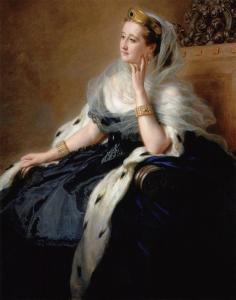
Empress Eugenie enemy / friend Sisi.
This time there will be the usual biography to present this character, but rather an interesting document that I found and is titled:"The Empress Eugenie in the memories of Marie des Garets"(Her maid of honor)The beautiful Eugenia de Montijo, Empress of France, stayed in Castellammare April 1877, when he was fifty and six lived in exile.She was born May 5, 1826 in Granada, daughter of Grandee of Spain Cipriano de Palafox y Portocarrero, and was educated at the Sacred Heart of Paris according to the principles of strict Catholicism, which had deeply influenced his character and his ideas.It was also appreciated for her intelligence, as well as for its charm and elegance (as well as his shoulders, judged the most beautiful in Paris), and in 1853 Louis Napoleon, who became in 1852 the Emperor Napoleon III, 'married her, while not loving her, and the marriage was born in 1856, Napoleon Eugene Louis.The empress Eugénie had been able to exert influence over her husband, also trying to divert his liberal tendencies and its policy filopiemontese and anti-papal, and was regent more than once. Both were unhurt in the attack organized in Paris in 1858 by Felice Orsini against the imperial procession, which had resulted in 8 deaths and more than 150 injured. But in 1870 there had been a disastrous defeat at Sedan, during the Franco-Prussian War and the immediate proclamation of the republic in France. Napoleon was captured by the Prussians and released at the conclusion of peace, in March of '71 had repaired with his wife and son in England, Kent, Chislehurst, where he died two years later.It was in 1876 that Eugenia decided to take a trip to Italy, with stops in Milan, Florence and Rome, before moving to Spain.The accompanied few intimate including his nephew Count Primoli and Marie De Larminat (1848-1925), future Countess Des Garets, a beautiful woman with large eyes blacks, who had been since 1868 his young maid of honor, and had remained loyal and very close, to which we owe the writing of Souvenirs d'une Demoiselle d'honneur, in two volumes published posthumously by his daughter in the years 1928-1929, the first subtitled Auprès de l'Imperatrice Eugenie, Empress Eugenie and the second en exil (which is also the tour in Italy and contains steps we reported in translation); Souvenirs, that, with regard to travel, they were brightened by the impressions made on the spot by Marie in letters to loved ones and herself fished, " in their intact form and family, "among the papers of the house.After visiting Rome, Eugenia also wanted to go to Naples, according to the story of Marie, douceur to prolong his stay in Italy:"We were coming to the end of our stay in Italy. To prolong the sweetness, the Empress stopped a bit 'of time in Naples and took with him two of his nephews, Count Primoli that was to accompany us to Spain, and the Marquis of Roccagiovine. "It was April 11, 1877. The group went by train to Naples, where he found a depressingly gray sky, and went immediately to Castellammare, chosen as the ideal place to choose to stay and hike; Stabia from the station, due to the usual onslaught of beggars arrival of the train, quickly reached the hotel Quisisana:"On April 11 we leave Rome and arrive at four o'clock in Naples. Alas! the same time, the same color of the sky between Dover and Calais in November. Immediately take the train to Castellammare, a swarm of beggars welcome us and we reach the hotel Quisisana in a hurry. "It was the largest Boccapianola Casino, located on the road to Quisisana was then known as the hotel, even if it was not for a long time more, and shot down after the damages suffered in the earthquake of 1980 to give way to a modern building. So he had described the Parisi in 1842:"In the midst of a magnificent villa it lies [...]. The this is a grand and elegant casino with bellissim'aria and surrounded by many picturesque views. One else has even a plant of hot and cold baths, a billiard room and a lovely theater dedicated to the Muses. The terraces corresponding to the noble apartment are very rare taste and amenities. People of the Royal Family and high-ranking year always chosen the living room of this mess. His villa is known under the name of Villa à-Donica and its entry to the meeting of the Least Reformed church of S. Francis ".The next day the weather improved, propitious for an excursion to Naples. Therefore Eugenia decided to have lunch at the hotel very early and ordered Italian dishes. Surprisingly, the two ladies, accustomed to fine French cuisine remained enraptured in front of a plate of macaroni, maybe a pie, full of everything: "The next day the weather clears, we have lunch early, the Empress is done only serve Italian dishes and, among other things, a dish of macaroni which corserviamo always remember, there's everything in there, is exquisite and indefinable. "In Naples, visited the Museum Bourbon, but the city was showing all his misery through its beggars, and Eugenia got angry at the very mention of the Neapolitans. In the evening they returned to the hotel Quisisana, joined by Prince Placido Gabrielli, the son of Carlotta Bonaparte:'Towards evening, we leave this half crazy Naples and return to Castellammare. We are very pleased to be joined by Prince Gabrielli descended to our hotel. "At this point there is an interesting digression on these his memories of Marie, who wanted to be true, more than beautiful:"We must first of all show true and I will not try to beautify my memories under the pretext of having been able to enjoy what everyone admires unanimously."And in fact she also expressed some reservations about the excavations of ancient Pompeii, while he would not shut up about the beauty of the road from Castellammare to Sorrento:"What fascinates us is the beautiful road from Castellammare to Sorrento, we cross the evening, at sunset, trying to cheer up the Empress by sharing our impressions»In Sorrento made a visit to the Countess S. Fiore Vittoria hotel, but not showed to appreciate a tarantella danced by women without grace and vulgarity.On April 14, they went to Capri and visited the Blue Grotto. On the way back they took a walk on the donkey and then returned to the hotel. Even at this point, Marie allowed herself a few thoughts:"On the way back we take a nice walk on the donkey and at sunset we return to the hotel.In this country of softness and bliss, really numbs you a bit 'in the moral as in the physical oblivion and dream merge in spirit, every feeling deep escapes.Everyone in our group, of different impressions, the Empress here reminiscences of Spain and often evokes the beautiful nights of the East; Primoli is exalted in a continuous stream, and indifferent to the man laying Roccagiovine lived; Prince takes sketches, sketches beautiful watercolors by the end tone and nuanced as his whole person: always and in all circumstances, the note just and true. "Later on (probably the 15th) were in Portici, 16 visited Bay and Cuma, then the collections of the Duke of Marina and Prince Filangieri.April 19, Eugenia settled for the next day's departure for Messina and in fact the 20 we went to Naples for lunch by Sclafani, cousins of the empress, and awaiting the departure of the ship, was visited the beautiful villa of Prince Column Capodimonte, from where they were admired for the last time the countries left:"It's there, of course, that you have the most beautiful view of Naples: the horizon we spot the beautiful country where we stopped: Castellammare, Sorrento, Massa, fascinating nests of flowers and greenery on the banks of the great blue mirror, which refers to them, in freshness and in whispers, all their scents and their songs. "Then he sailed to Messina, without Roccagiovine and Gabrielli left in Naples, bringing with it as best I remember that the beautiful evenings spent Quisisana:"The best memories that we carry with us is one of the beautiful evenings spent in the small hotels of Castellammare, at the time of return from our travels more or less strenuous; stopped every sound, every movement was canceled, and on the terrace we remained in silence and ecstasy in the infinite sweetness of the spring night. I dare not speak to the Empress who reproaches me for the tents everywhere and not being able to leave anything. "The crossing was hard and painful. They visited Messina, Catania, Syracuse, where he again embarked for Malta. Leaving Italy, Marie wanted to evoke the most beautiful things or details of which kept the memory:"Through all the little disappointments and difficulties inseparable from a journey, that delicious memories!After the great emotions of Rome there was a happy stop in a lovely country, Castellammare and its fragrant nights, Sorrento and its beautiful balconies hanging over the sea, and our evening walk along the ravine that made the night so dark. Porches and the small inn where we had lunch so cheerfully, our long conversations confidential, this collection of poetry, friendship and good humor that summarizes our short trip. The Empress, dimenticatasi for a few days of his harrowing concerns, let take our joy; ourselves did not think that the present hour and we ended up believing that there is on earth that the rays of the sun and scented nights. There is no rich country but what made him feel so much sweetness of life! ... ".In Malta, against a British officer who insisted on knowing his impressions of Naples, Marie gave an unusual answer: "Do not try to explain, but I tell the amusing idea of a Neapolitan who told me that the good God, in his days of boredom, a small hole in the sky, bends, looking at Naples ... and smiles. "After this trip, in 1879, Eugenia was hit by another and more terrible pain, his son's death, which took place in Africa in England's war against the Zulus. The author of Souvenirs still wanted to note how, after that last play, the memory of the good times we had at Castellammare and around Naples, however, was the Empress of relief: "Very often, later, his thoughts went back to those hours whose memory the apportava still some sweetness." In 1881 Marie married Count Louis-Marie Des Garets, so he could no longer offer their services as before.Eugenia moved to Farnborough in Hampshire in 1885, but also lived in Cap-Martin at Cannes. He died in Madrid, where she had gone to visit relatives in 1920 to ninety-four years.His devoted Demoiselle d'honneur died five years later, in 1925, at seventy-seven.
From the site: http://www.stabiana.it/spigol25eugenia.htm
Charlotte of Belgium................and Maximilian of Habsburg-Lorraine
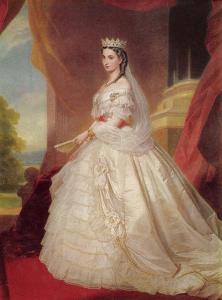
Charlotte of Belgium................and Maximilian of Habsburg-Lorraine
Charlotte of Belgium (Marie Charlotte Amélie Augustine Victoire Clémentine Léopoldine; 7 June 1840 – 19 January 1927) is remembered today as Carlota of Mexico, empress consort of Emperor Maximilian I of Mexico, the former Archduke of Austria. Princess of Belgium The only daughter of Leopold I, King of the Belgians (1790–1865) by his second wife, Louise of Orléans, Princess of Orléans (1812–1850), Charlotte was born at the Royal Castle of Laeken in Laeken, Brussels, Belgium. Charlotte had three brothers: Louis-Philippe, who died in infancy, Leopold, who on the death of their father became Leopold II of Belgium and Philippe, Count of Flanders. She was also a first cousin to both Queen Victoria of the United Kingdom and her husband, Prince Albert, as well as Ferdinand II of Portugal. She belonged to the House of Saxe-Coburg and Gotha. Her favorite grandparent Maria Amalia of the Two Sicilies, Queen of France, was the consort of Louis-Philippe of France, and a niece of Marie Antoinette. Maria Amalia was Charlotte's close confidante, and on her wedding day in 1857, she wore a bracelet with a miniature portrait of her. They regularly corresponded, especially later while Charlotte was in Mexico. When Charlotte was ten years old, her mother, Louise-Marie, died of tuberculosis and Charlotte was entrusted to the Countess of Hulste, a close family friend. Although young, the princess had her own household; but for a few weeks out of the year, Charlotte stayed in Claremont with Maria Amalia and the rest of her mother's family in exile. Archduchess of Austria On 27 July 1857 in Brussels, Charlotte married her second cousin Archduke Maximilian of Austria, the idealistic younger brother of Emperor Franz Josef of Austria. In the Court of Vienna she was much prized by her mother-in-law, who saw in her the perfect example of a wife to an Austrian Archduke. Charlotte disliked Empress Elizabeth (also known as Sissi, Franz Josef's wife). It is said that the archduchess disliked the deep connection that existed between the empress and Maximilian, who were confidantes and shared the same tastes for many things, especially because her sister-in-law was universally admired for her beauty and charms. Charlotte spent several relatively happy years in Italy as Maximilian's wife while the archduke served as governor of the provinces of Lombardy and Venetia. Although Lombardy and Venetia were then under the rule of the Austrian Empire, neither Maximilian nor Charlotte held real power, and both were fatally eager for more challenging roles in life. Empress of Mexico In the early 1860s, the ambitious Napoleon III initiated the French intervention in Mexico. France, eager to turn Mexico into a satellite state, searched for a suitable figurehead to serve as the nominal emperor of Mexico. Maximilian accepted the Mexican crown and the couple sailed for the New World. The imperial couple were crowned at the Catedral Metropolitana in 1864 and chose as their seat Mexico City, making their home in the Neoclassical Castillo de Chapultepec. As Empress, Charlotte took the name of Carlota (Spanish for Charlotte). Carlota tried to take her imperial duties seriously, and even undertook a tour of the remote Yucatán frontier, visiting the ruins of Uxmal. Only months after the coronation, however, Napoleon III began signaling his abandonment of Maximilian, and the French began to withdraw their troops from Mexico. This strategic pullback was a potentially fatal blow to the infant Mexican monarchy. The situation was exacerbated by a United States blockade that prevented French reinforcements from landing. In a desperate attempt to save her husband's throne, Charlotte returned to Europe, seeking assistance for her husband in Paris, Vienna, and finally in Rome from Pope Pius IX. Her efforts failed; she manifested symptoms of paranoia, suffered a profound cognitive and emotional collapse, and never returned to Mexico. Family Charlotte and Maximilian had no children, but in 1865 the imperial couple adopted Agustín de Iturbide y Green and Salvador de Iturbide y de Marzán – grandsons of Agustín de Iturbide y Arámburu, an earlier emperor of Mexico (r. 1822-23). They gave two-year-old Agustín the title of "His Highness, The Prince of Iturbide" —similar imperial titles were accorded to various members of the child's extended family—but he never intended to give him the throne, because he was not of royal blood.[1] Maximilian explained himself that it was all a charade to get his brother Archduke Karl Ludwig of Austria to give him one of his sons as heir.[1] The explosive events of 1867, dashed any hopes of inheritance, and after he grew to adulthood, Agustín renounced all rights to the Mexican throne, served in the Mexican army, and eventually established himself as a professor at Georgetown University. Rumors persist that, in 1866, Charlotte was having an affair with Belgian officer Colonel Alfred Van der Smissen and that she gave birth to a son, Maxime Weygand, in Brussels on 21 January 1867. Weygand refused to confirm or deny the persistent rumor and his parentage remains uncertain. Weygand was a French military commander in both World War I and II.1 The empress dowager President Benito Juárez of the Republic of Mexico oversaw the execution of Maximilian in 1867. (His last words were reportedly of his absent wife: "Poor Carlota!"[2]). The empire had collapsed after only three years. Carlota's mental state continued to be poor. Her brother Prince Philippe, Count of Flanders, had her examined by alienists (psychiatrists), who pronounced her insane. She spent the rest of her life in seclusion, first at Miramar Castle near Trieste, Italy, and then at the Castle of Bouchout in Meise, Belgium. During World War I, her Belgian estate was surrounded by the occupying German army, but the estate itself was sacrosanct because Austria was one of Germany's chief allies and she was the widowed sister-in-law of the Austrian emperor. As Charlotte's illness progressed, her paranoia faded. She remained deeply in love with her husband. After his death, she cherished all of the surviving possessions they had enjoyed in common. The bias of the historiography of the time makes it difficult to assess to what extent she suffered from alleged mental conditions such as psychosis, paranoia and monomania. Her considerable fortune as one of the richest women of Europe was administered by baron de Goffinet, a servant of King Leopold II, who ensured that the money was used for his personal colonization of the Congo. Charlotte died of pneumonia brought on by influenza at the Bouchout Castle, in Meise, Belgium, on 19 January 1927, and is buried at the Church of Our Lady of Laeken. From site : http://en.wikipedia.org/wiki/Charlotte_of_Belgium
Kronprizessin Stephanie von Osterreich Prinzessin von Belgien
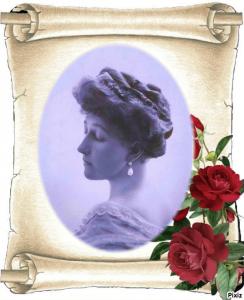
A portrait of Stephanie von Belgien............a failure Empress
Princess Stephanie was the second daughter of King Leopold II and Queen Marie-Henriette. Born May 21, 1864, she spent a sad childhood at Laeken Castle. Like her sisters, she suffered severely from her parents' marital unhappiness and harsh educational methods. The later Princess Marie-José of Belgium recalled reading, as a little girl, Stephanie's youthful diaries. "She was a melancholy person....from childhood, she dreamed of a great love," Marie-José remembered (Regolo p. 21). Like her sisters (all in their different ways), Stephanie, starved of tenderness as a child, would, as an adult, stubbornly pursue love. Yet she did not win it before many vicissitudes and sorrows. At 15, Stephanie was courted by Crown Prince Rudolf of Austria-Hungary. The Belgian Sovereigns were determined on this prestigious match, and urged their daughter to accept Rudolf's hand. In 1881, the couple were married in Vienna. Their marriage initially seemed happy, and, in 1883, they had a daughter, Elisabeth ("Erszi"). Stephanie was a conscientious Crown Princess, often fulfilling official duties for the (frequently absent) Empress Elisabeth.Sadly, however, Rudolf and Stephanie drifted apart. The Princess' deep piety and conservative opinions placed her in opposition to the Prince's liberal notions. Rudolf also led a dissolute life; as a result of his infidelities, Stephanie is believed to have contracted venereal disease. In any case, she became infertile. Meanwhile, she also suffered from a difficult relationship with her hostile mother-in-law, Empress Elisabeth. In 1889, her marriage ended in the infamous Mayerling tragedy. According to the official version, Rudolf and his young mistress, Marie Vetsera, committed suicide in a doomed lovers' pact at the Mayerling hunting lodge; the later Empress Zita, however, asserted they were murdered by French or Austrian agents as a result of a political plot. The scandal arising from the tragedy was deeply humiliating to Princess Stephanie, and isolated her further from the Austrian court. To escape the situation, she undertook extensive travels through Europe. She also worked on her memoirs and oversaw the compilation of a history of the Austro-Hungarian monarchy ( a project begun by Rudolf). The final volume was published in 1902. In 1900, Stephanie re-married. The choice of her heart was a Hungarian nobleman, Count Elemér Lonyay. Her parents were furious. King Leopold refused to recognize a mere count as his son-in-law, and disinherited Stephanie, stripping her of her Belgian royal titles. After Queen Marie-Henriette's death in 1902, Stephanie and her older sister, Louise (also disgraced and disinherited), tried to sue their father in court, demanding a share of their mother's wealth, but in vain. Later, after King Leopold's death in 1909, the princesses would sue the Belgian state, unsuccesfully attempting to obtain part of their father's fortune. During World War I, Stephanie entered the service of the Red Cross. After the return of peace, she lived an extravagant life. As a result of gambling debts and disastrous business ventures, she lost most of her money during the 1920's. More vicissitudes would follow; during World War II, Soviet troops invaded her property in Hungary. She and her husband took refuge in the Benedictine abbey of Pannonhalma. Here, on August 23, 1945, Stephanie died. Estranged from her daughter, she willed much of her remaining wealth, as well as her personal archives, to the abbey. Her memoirs were eventually published under the title I Should Have Been Empress. From site : http://crossoflaeken.blogspot.com/2009/07/princess-stephanie-of-belgium.html
Montecuccoli House of Modena .............a faithful family to Vienna
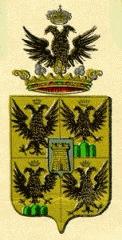
Montecuccoli House of Modena .............a faithful family to Vienna
Montecuccoli houseHistory The roots of the family date back to the 11th Century in the Duchy of Modena back. Headquarters, the castle was Montecuccolo (Eng.: Kuckucksberg) at Modena. Male members of the family went into the imperial service. 1530, the family of the Emperor Charles V was raised to the imperial counts. Count Ernesto Montecuccoli (1582-1633) was an imperial general in the Thirty Years War and fought under Wallenstein. Emperor Ferdinand II granted him the fief in 1624 with the reign Hohenegg His nephew Imperial Count Raimondo Montecuccoli (1609-1680) was an Austrian imperial commander, diplomat and statesman, military theorist, and writer and creator of the first standing army in Austria. He is next to Prince Eugene and Archduke Charles of Austria as the leading commander. Other important members of the family were Alfonso Montecuccoli, Admiral of the Grand Duke of Tuscany led, 1607, a small fleet against the Turks Montecuccoli Girolamo (1583-1643), confidential finance the Grand Duke of Tuscany and commander over his German bodyguard, later Prime Minister and Council of Leopold V of Tyrol Leopold Montecuccoli Philipp (1662-1698), Imperial Habsburg field marshal lieutenant, son of Raimondo Montecuccoli Montecuccoli Rudolf (1843-1922), k.u.k. Austro-Hungarian navy admiral and commander Counts as one of 64 families, the family had a hereditary seat in the House, the Upper House of the Austrian Empire Council. Possessions Since 1710, Good Mitterau located in the municipality Markersdorf an der Pielach near St. Pölten in the possession of the noble family, with 950 hectares of forest. The castle was built in 1600 and received its present form in 1754. By 1740, Earl moved Zeno Montecuccoli the seat of power of the nearby castle Hohenegg Mitterau. [2] it is today Managed by Albert and Felix Montecuccoli. [3] References First ↑ Thomas Jordan: "Clear mandate". In: noblesse oblige: a series of NÖN. Lower Austrian news, 11 October 2010 accessed on 17 May 2012. 2nd ↑ Thomas Jordan: "Clear mandate". In: noblesse oblige: a series of NÖN. Lower Austrian news, 11 October 2010 accessed on 17 May 2012. 3rd ↑ Thomas Jorda: Stuff better. In: noblesse oblige: a series of NÖN. Lower Austrian news, 23 April 2012 accessed on 17 May 2012.Dal sito: http://de.wikipedia.org/wiki/Montecuccoli_ (noble)
Zita of Bourbon-Parma (last Empress of Austria / Hungary).
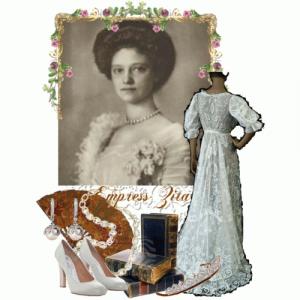
Zita of Bourbon-Parma (last Empress of Austria / Hungary).
Princess Zita of Bourbon-Parma (whose full name was Zita Mariadelle Grazie Adelgonda Micaela Raffaela Gabriella Giuseppina Antonia LuisaAgnese) was born May 9, 1892 at Villa Pianore, near Viareggio, Province ofLucca. She was the wife of Emperor Charles I of Austria and Empress of Austria and Queenof Hungary. Descendedon his father's side of the ducal family of Bourbon-Parma and his mother's sidefrom the real one of Braganza of Portugal.
Childhood,education and international religious
Zita was the seventeenth of the many children (twenty-four) of the Duke Roberto I ofBourbon-Parma. The Duke had the first twelve children by his first wife Maria Pia of the TwoSicilies. Widowed in 1882, two years later he married Maria Antonia of Portugal, daughter of KingMiguel of Portugal, with whom he had twelve other children. The large familylived in Villa Pianore (a large property located between Pietrasanta andViareggio, in Tuscany), mostly in the autumn and winter months and for theremaining part of the year in the castle of Schwarzau in Lower Austria. The young man was blessed childhood that fostered in her a spontaneous trust inlife, helping to control both the bitterness and envy. A Zita and his brothers were taught Italian, French German, Spanish, Portugueseand English. He attended an English school in Ryde, Isle of Wight and a conventschool in Zanberg in Upper Bavarian where education was geared towardsreligious education, and the learning of other subjects including Latin,philosophy, history and music.
The courtship and marriage
Charles and Zita were known to children, but they had not met for at least ten years. In 1909 the regiment of dragoons in which the militant young Charles of Hapsburg,was transferred to Brandeis on the Elbe in Bohemia where he had the opportunityto visit several times his aunt, the Archduchess Maria Theresa, in the spa townof Franzenbad. Here he saw the playmate of Schwarzau and there arose animmediate liking. At that time, Charles was asked to marry (Franz Ferdinand, his uncle and first inline of succession, he married morganatically and his sons were thus excludedfrom the succession to the throne) and Zita, the Italian princess ofBourbon-Parma, young, beautiful, lively and at the same time devotee, had apedigree of appropriate rank. To be able to approach her, Charles sought the help of Archduchess Maria Theresa,who was also one of the aunts of Zita. The Archduchess agreed to help his nephew and organized in his estate, a huntlasting eight days also inviting the two young men who had the opportunity tomeet and get to know each other. Between the two young there was a natural attraction due to the difference ofcharacter. As a couple, they were so complementary: he could never fall in lovewith a woman tasteless, as provided requirements dynastic neither she needed aman vain, arrogant and irresponsible, as of royal blood. The June 13, 1911 Zita officially engaged to Charles in the Pianore Villa at Luccain Italy. In the same year, on October 21, the couple were married in the castle ofSchwarzau am Steinfeld (Lower Austria) after reading the protocol ceremonial,liturgical texts and various prayers connected with the marriage, under thespiritual direction of the Jesuit father Carlo Maria Andlau. The marriage was celebrated by Monsignor Camillo Bisleri, delegate of Pope Pius X,who read the speech specially prepared by the Pontiff. Trained in the principles of the Catholic religion, the two young men had the highestopinion of marriage, not only as a sacrament of the founding family, but alsoas a means of improving mutual.
The honeymoon, married life, the birth of the first child
The took place from his residence in the country of Reichenau (in Tyrol),Degree (in Austrian Friuli), Dalmatia and Bosnia. As a first step of the honeymoon, the couple went to the shrine to ask Our Lady ofMariazell his protection. In just ten years of married life were born eight children, the first, Otto, wasborn Nov. 20, 1912. The news that changed their lives, the series of events that led to the throneCharles and Zita June 28, 1914 Charles and Zita were in Reichenau, a country residence. At noon,while waiting for lunch, a telegram arrived: "Deeply saddened communicate death His Imperial Highness et Duchess, both assassinatedin Sarajevo today. Signed Rumerskirch ". Archduke Franz Ferdinand and his wife Sophie were assassinated in Sarajevo by GavriloPrincip, a Bosnian Serb nationalist. Charles and Zita would then become Emperor and Empress of Austria-Hungary in anextraordinary series of events: the Archduke Rudolf, the only son of theEmperor, had died in mysterious circumstances in Meyerling with lover MaryVétzera and not had left sons. The younger brother of Franz Joseph Maximilian,Emperor of Mexico, had been shot by the revolutionaries in 1867. The secondbrother of Franz Joseph, Archduke Karl Ludwig, had died in 1896 after drinkingpolluted water of the Jordan River. So he became Crown Prince Archduke FranzFerdinand, the son of Charles Louis. However, because of his morganaticmarriage with Countess Sophie Chotek with Bohemian Chotkova, he was forced toforego his rights to the throne for their children, and to accept aspresumptive heir his brother Otto, the father of Charles. But Otto diedprematurely and Franz Ferdinand was assassinated in Sarajevo.
World War I and Zita
The war was a very tragic event for Zita because of his brothers, Prince Felix andPrince René saw service in the Imperial Austro-Hungarian Empire while PrinceSixtus and Prince Xavier were enlisted in the Belgian army. Unfortunately, when the Kingdom of Italy in 1915, rejected the alliance that bound her toAustria and joined the hostile powers to the Central Powers, rumors began tocirculate of unfavorable sull'italiana wife of the Emperor.
The coronation, commitment to peace
Charles and Zita were crowned in Budapest December 30, 1916, while World War I raged. Since the beginning, Zita worked together with her husband Charles and with the helpof Sixtus and Xavier of Bourbon-Parma to put an end to the massacre and for theachievement of peace.The innovative way of life of the imperial couple The family and devotion to God were the priorities of Charles and Zita.Theirway of relating to the world was at the time modern and innovative: Zita wasalways held in high esteem and respect from Carlo, conscious of the gravity ofthe situation and the difficulty of the decisions that had to be taken in theaffairs of domestic and foreign policy , often asked advice of his wife.Zita,again moving away from the traditional model, accompanied her husband in thevarious provinces of the Empire and also to the war front in addition to dealwith acts of charity and visits to the war-wounded in military hospitals.
The collapse of the centuries-old Habsburg Empire, exile
At the end of 1918, the centuries-old Habsburg Empire collapsed. In its placearose the new states of German Austria, Czechoslovakia, Hungary, the State ofSerbs, Croats and Slovenes, while other parts of the territory were occupiedand then annexed by other countries such as Italy, Romania, Poland and UkraineCharlesand Zita were forced to go into exile, first in Switzerland and, after twoattempts at restoration in Budapest, in Funchal on the island of Madeira.Becauseof the hardships, Charles died of bronchial pneumonia on April 1, 1922. Thelast words he spoke, grateful to his wife, eight months pregnant, constantlyattended to him were: "I love you so much."Afterthe funeral, a witness said of Zita "This woman must be truly admired. Shedid not lose even for a second ... his composure greeted the 30,000 gathered atthe ceremony and spoke to those who made it possible for the funeral. Alladmired her very much. "Zitabrought mourning in memory of Carlo during the 67 years of widowhood.DevoutCatholic, became a widow at the age of 29 years, mother of a large family, heremained faithful to the memory of her beloved husband for the rest of his longlife.The help of the King of Spain, the departure from Funchal, the arrival in Spain andthe birth of the Archduchess Elisabeth, the palace Uribarren Lekeitio(Lequeitio .After the death of Charles, the imperial family was allowed to leave Funchal and goto Spain. This was possible thanks to the direct involvement of the King ofSpain Alfonso XIII of Bourbon, who had contact with the British Foreign Officethrough its ambassador in London. Alfonso sent the warship Infanta Isabel toFunchal and transported Zita with their children in Cadiz.Theywere escorted to the Pardo Palace in Madrid, where shortly after his arrivalZita gave birth to the Archduchess ElisabethAlfonso XIII offered his exiled relatives the use of the building Uribarren Lekeitio(Lequeitio) in the Bay of Biscay. Here Zita stayed for the next six years wherehe grew up and educated their children Thefamily lived struggles with financial difficulties, remaining, for the mostpart, with the income of some private property and because of the sums of moneycollected from supporters.Themove to Belgium, the contacts with the Kingdom of Italy, the possibility of arestoration, the Anschluss, the resistance against Nazism In1929 the sons of Zita were approaching age to attend university so, inSeptember, the family moved to Belgium in the village of Steenokkerzeel nearBrussels where, among other things, were closer to some of their relatives Alsoin this period Zita continued his activities in support of the Habsburg familyby contacting the emissaries of the Kingdom of Italy.Therewas even the possibility of a restoration of the Hapsburgs during thegovernment of Chancellor Engelbert Dollfuss and Kurt Schuschnigg. At that timethe Crown Prince Otto of Austria visited frequently. These openings wereabruptly interrupted with the annexation of Austria by Nazi Germany in 1938. Exiledfrom the Habsburg family took command of the resistance against the Nazis inAustria, but the movement failed to develop properly due to conflicts arisingbetween the monarchists and socialists.Thebombing of the imperial family, moving to France, moving to Portugal, thetransfer to the United States of America, the transfer in Quebec in CanadaAfterthe Nazi invasion of Belgium, May 10, 1940, Zita and her family had to fleebecause they wanted by the authorities of the Third Reich. Theyescaped an assassination attempt in their lives when the castle that housedthem was attacked by German bombers. Then took refuge in the French castle ofPrince Xavier of Bourbon-Parma Bostz. When in France collaborator PhilippePetain took power, the Habsburgs had to flee to the Spanish border, catching upon May 18. From here left for Portugal and here the Government of the UnitedStates of America have made them the necessary documentation to travel to NewYork, July 9. They arrived in that city on July 27, settling first in LongIsland and then to Newark, New Jersey. Later they lived for a time in TuxedoPark in New York. Eventually settled in Quebec in Canada.
The family's role in World War I
Otto suggested the role of the Habsburg dynasty in postwar Europe and met regularlyFranklin Roosevelt. Robert was the Habsburg representative in London.CarloLudovico and Happy enlisted in the Army of the United States of America.Rudolfwent underground in Austria to help organize the resistance against the Nazis.Therole of the family after the Second World War, the transfer ZizersIn1945 the Empress Zita celebrated his birthday on the first day of Peace, May 9.The next two years raised funds in the United States and Canada, to bemallocated to the people of Austria and the neighboring countries, severelyaffected by the war. Zita returned regularly in Europe for the weddings of her children. In 1952 hedecided to return permanently in Luxembourg to take care of his elderly mother,Maria Antonia.The Bishop of Chur proposed to Zita to settle in a residence that he administered(formerly a castle of the Count of Salis) Zizers, Graubünden in Switzerland, inorder to gather the whole family and she accepted.Theprogressive abolition of restrictions on entry of the Habsburgs in Austria Restrictionson entry of the Habsburgs in Austria were abolished at some point but thisapplied only to members of the family born after April 10, 1919. Because ofthis arrangement, Zita, with great regret, could not be present at the funeralof his daughter Adelaide in 1972.Just in 1982, she was allowed to return to Austria for the first time in sixty years.
The last years of life
After the ninetieth birthday of Zita's health began to deteriorate.In1988 he became ill with pneumonia and was in bed for most of autumn and winter.In the month of March 1989 called him near his son Otto, saying that it hadreached the end of his earthly journey. Otto and the rest of the family in turngave the change to her bedside in her company until the early hours of March14, 1989 died at age 96 years. The solemn funeral in Vienna and BudapestOn1 April 1989, she was bestowed solemn funeral in Vienna, where he was buried inthe crypt of the Capuchins, the last residence of the Habsburgs. Ceremonieswere two hundred members of the family Habsburg and Bourbon-Parma as well asmany politicians, many diplomats together with the representative of Pope JohnPaul II and other Church dignitaries. Afterthe solemn funeral held in Vienna for the last time according to the protocolof the former Habsburg court, was celebrated in Budapest, a few days later, asolemn requiem in his honor in the church where Charles and Zita were crownedKing and Queen of 'Hungary. Commitmentto Peace, the process of canonization of the Servant of God Zita,Empress and Queen, lobbied hard with her husband for Peace, in this exemplarydeparting from the action of governments across Europe, instead, sought toachieve the greatest possible benefit in terms of territorial conquests andpresumed future economic benefits, without taking into account any of thehorrors and sufferings of the great slaughter which was the European war of1914-1918. In this extraordinary female personality, who was committed to peace and socialjustice and who represented a new pattern of behavior and positive, paidtribute with words of condolence also Pope John Paul II.Alreadystarted, also thanks to Zita, the process of canonization for her husbandCarlo, after the beatification October 3, 2004, the Church authorities havealso started to Zita the canonical process. Today it is considered one of theServants of God, that is, between those who have distinguished themselves by"sanctity of life" or "heroic virtues." From the site: http://www.nuovolitorale.org/zita.asp




